“A Fine Kettle of Fish”
Four passages taken from different times and places:
- Ys.9:11, tr. Ilya Gershevitch:
“…the horned dragon, horse devourer, men-devourer,
yellow and poisonous, had yellow poison
mounting on him to the height of a spear.
On the back of this dragon Keresaspa the hero
happened to stew his meat in a kettle
at lunchtime.
The monster began to be hot and transpire;
he darted forth with a jolt
spilling the boiling water:
heroic Keresaspa fled in terror.” [1]
- The History of Beyhaqi II: The Section on the History of Khwarazm (based partially, according to Beyhaqi, on Biruni’s account)
“The mass of common people, however, are so constituted that they prefer impossible absurdities, …as when some fool kicks up a commotion and a throng of likeminded people gather round him, and he regales them with such things as, “In a certain sea I saw an island and five hundred of us landed on that island; we baked bread and set up cooking pots, and when the fire got going and its heat reached down into the ground, it moved; we looked and lo and behold the island was a fish.” Or, “On a certain mountain I saw such-and-such things, as an old sorceress turned a man into an ass, and then another sorceress smeared his ear with some kind of unguent and changed him back into human form,” and other such nonsensical tales that bring sleep to the ignorant when read to them at night.” [2]
- From Florence McCulloch, Mediaeval Latin and French Bestiaries:
“[Physilogus Latinus B (ed. Carmody, Versio B, 24)] begins with a statement that there is a sea monster called in Greek aspidochelone and in Latin aspido testudo. Because this large creature’s back is covered with sand, sailors think it is an island on which they alight. To cook their food, they make a fire, but when the whale feels the heat, it submerges and drags the ship to the depth. When hungry, the whale opens its mouth and emits a pleasant odor. Small fish are thus attracted into the whale’s mouth, which soon closes on them (ed. Carmody Versio Y, 30) …According to the allegory the sailors are the incredulous who, ignoring the wiles of the devil, put their trust in him and sink with him to hell. The small fish are men of little faith who are destroyed by the lures of the devil…” [3]
[Note: The Mid.Eng. Phys. p.13ff. with ‘significcio’ p.14.; Caxton pp. 88-89 “In this see of Ynde is another fysshe so huge and grete that on his backe groweth erth and grasse; and semeth proprely that it is a grete Ile. Wherof it happeth somtyme that the maronners sayllyng by this see ben gretly deceyued and abused…”]
- “One key episode [in The Adventures of Pinocchio], included in the Walt Disney film as well, has Pinocchio, who has been transformed into a donkey, tossed into the sea. There he is freed, with the help of countless fish, from the donkey skin in which he has been unhappily enveloped. But a sea monster (a frightful shark in Carlo Collodi [Lorenzini, 1826-1890]; a furious whale in Disney) swallows him. In the belly of the monster, Pinocchio comes upon his father figure, Geppetto, who has been living there for two years. Eventually Pinocchio escapes. In the Disney version the escape comes about when the boy lights on (so to speak) the idea of setting on fire Geppetto’s boat. The smoke and fire cause the sea beast such discomfort that, before long, it belches out Pinocchio, Geppetto, and the cricket Jiminy, who eventually are washed safely ashore.”[4]
In the first and earliest account we hear ancient and frequently muffled voices, preserved mostly in late manuscripts and dependent on the efforts of scholars to clarify the frequent lacunae and smooth the staccato syntax.
Kərəsāspa / Karsāsp appears several times in the Zoroastrian literature in heroic combat with demonic monsters and in his eschatological role as a dragon-slayer. [5] His exploits as the slayer of Aži Sruuara, the horned dragon, and the giant Gandarəβa are merely alluded to in the Avesta, but elaborated in the Middle Persian writings, and his slaying of Aži Dahāka, the dragon-like monster with three mouths, three heads, and six eyes, is found only in the Middle Persian and later texts. According to Zāmyād Yašt (§19.38-40) when Fortune left Yima/Jam, the ruler of the golden age, it was caught by Karsāsp, the strongest of strong men in respect of manly courage except for Zarathustra himself. He had killed Aži Sruuara, the giant horned dragon who swallowed horses and men, the poisonous yellow creature over whom poison flowed the height of a spear.
The text recounts that Kərəsāspa was cooking his meal in a pot at midday, apparently unaware of the fact that he was sitting upon the back of the sleeping horned dragon. The blazing heat from his fire made the dragon swelter and wake up. The dragon shook himself violently, the pot overturned and extinguished the fire beneath it, and the terrified Kərəsāspa sped away. Later he eventually succeeds in killing the dragon (Yasn 9.1; Yašt. 19.40).
Because of this incident, and in spite of his many victorious exploits, Karsāsp was sent to Hell for the inadvertent killing of the Fire, son of Ohrmazd. His ordeal of punishment is narrated in the Pahlavi Rivāyat and the Zoroastrian Persian texts: Ohrmazd summons Karsāsp’s soul from hell and expresses his displeasure with his soul, blaming the soul for extinguishing the fire rather than tending to it. His soul begs Ohrmazd to take pity on him and assign him to paradise in recognition of all the good deeds he had performed throughout his life: keeping evil out of Ohrmazd’s creation and preventing Ahriman from becoming its ruler.[6] Finally through the meditation of Gōšurun, the soul of the Sole-created Bull, and Zarathustra,[7] Karsāsp’s soul is dispatched to hamēstagān, the intermediate station between paradise and hell, where he lies unconscious or asleep till the end of the world when he will rise up to kill Aži Dahāg.[8] He will be the first among the living to be raised from the dead.[9]
Karsāsp (Garshāsp) also appears frequently in Persian literature in the centuries after the rise of Islam and is the eponymous hero of Asadi Ṭusi’s (d. 465/1072-73) epic poem, which describes at length the hero’s Alexander-like exploits and many journeys[10] to wondrous isles. The narrative accounts in Persian writings in different genres in the early medieval period are often at variance[11] and range from many pages to brief citations providing Karsāsp with conflicting lineages, such as, for example, the brief tabulated reference in Abu Rayḥān al-Biruni’s list of Persian kings in Al-Āthārʾl- bāqiya ʿanʾl-qorunʾl-khāliya, “Garshâsp, i.e. Sâm ben Narimân ben Tahmâsp ben Ashak ben Nôsh ben Dûsar ben Minûshjihr” (Sachau, p. 112).[12]
The quoted reference from Biruni brings us to the second passage above, the dismissal of the disturbed whale story as a fanciful bedtime story (samar, asmār), a piece of vulgar pulp fiction, of little instructive or historical value. There is no reference to Karsāsp and his ordeal.
It should also be noted that passage comes towards the end of the surviving volume of Beyhaqi’s Tārikh-e Masʿudi in his exordium (khoṭba) to his account of the history of Khwarazm where he relies extensively on Biruni’s no longer extant Ketāb al-mosāmara fi akhbār Khvārazm. Both Biruni and Beyhaqi are keen to assure their readers that they maintain scrupulously strict verification principles in their critical interpretation of the past, limited to what they perceive as rational premises where myths and fables have no place. Following the quotation above, where he sneers at the banality of the whale story, Beyhaqi turns to general observations on his approach to history and confides in his readers:
“So I, who have taken up this History, have made it incumbent upon myself to write either from my own direct observations or from sound information, heard from a reliable source. A good while ago, I saw a book written in the hands of Master Abu Reyḥān, who was peerless in his age in Adab, learning, geometry, and philosophy. He would never indulge in exaggerations, and I have given this lengthy passage from his [Biruni’s] book so that it may be firmly established how scrupulous I have been in writing this History.”[13]
The same insistence on either direct observation or reliable reporting appears in Biruni’s own preface to his magisterial work on India, Ketāb taḥqiq mā leʾl-Hend:
“No one will deny that in questions of historic authenticity hearsay [khabar] does not equal eye-witness [ʿiyān]; for in the latter the eye of the observer apprehends the substance of that which is observed, both in the time and in the place where it exists, whilst hearsay has its peculiar drawbacks. But for these, it would be even preferable to eye-witness; for the object of eye-witness can only be actual momentary existence; whilst hearsay comprehends alike the present, the past, and the future, so as to apply in a certain sense both to that which is and to that which is not (i.e. which either has ceased to exist or has not yet come into existence).[14]
Biruni then goes on to distinguish between different “reporters” [mokhberin] and the possible ways of lying, in order to avoid repeating fictitious accounts and to find a reliable reporter to convey a true account, as Beyhaqi had done in his own case.
The excerpt from Beyhaqi dismisses therefore the whole imaginative enterprise of explicating memories of this and other ‘marvels of the east’ and wonders why we should fabricate or preserve far-fetched fables when we have plenty of unambiguous well-attested historical exempla in store, relayed by reliable authorities, enabling us to observe admonitory patterns in history in the longue durée.[15] Myths are therefore left unacknowledged as such, needing no gloss or elucidation and placed in the rubric of a tale (qeṣṣa) mere fable (afsāna) or bedtime stories (asmār) and dismissed as such.
In the third example, from Medieval Latin and French Bestiaries as well Middle English texts, we come across one of several methods of retrieval and reinterpretation involving euhemeristic, allegorical and rationalizing strategies designed to separate the wheat from the chaff, myth from mere anecdote or fable. We have had to move from one continent to another and to a different culture and literature given the apparent diachronic disjuncture in the history of the burning fish narrative in Persian literature, from the pre-Islamic myth to the popular fable as described and dismissed by Beyhaqi.[16]
This cultural shift of focus also brings into play the emic and etic contours that have to be taken into account in comparative literary studies in general and studies of myth—a chameleon like concept— in particular and in the context of its travel through time, the longue durée.[17]Although with the burning fish story we face a dead end[18], there are many other examples of survival and re-interpretation of mythical narrative in Persian literature. And it is here that Ferdowsi’s Shahnameh, the long poem itself as well as its reverberations in the centuries that followed, performs its double task: not only preserving many narratives in a memorable metrical form, but becoming himself and itself—the poet and the book—a powerful source of myth, perennially ripe for decoding.[19] Its heroes have become active-even hyperactive-archetypes, leaving their original contexts to become part of the changing moral and political vocabulary of later times. These mutations are met with in poems classical and modern, in poets as diverse as Neẓāmi and ʿAṭṭār, or Akhavān and Bahār. They appear as part of the figurative vocabulary of medieval mystics and in the exegetic discourses of a modern intellectual such as Shahrokh Meskoub.[20]
An often neglected distinction must be made here between specific and direct borrowings from the Shahnameh, where the borrower is clearly indebted to the book’s own organization and interpretation of the past, and less precisely traceable use of the store-house of Persian legends which existed before, along and after the appearance of the Shahnameh and from which, of course, the Shahnameh itself drew its material[21]. Early external references to Persian myths by Greek historians (Herodotus, Xenophon, Ctesias) have been discussed by scholars writing on pre-Islamic oral poetry in Iran. But perhaps the most succinct and colorful illustration is from a famous passage in a later text, Moses of Khoren’s History of the Armenians (possibly 8th century):
“But what then is your delight in the obscene and ridiculous fables of Biurasp Azhdahak; and why do you trouble us for those absurd and incoherent Persian stories notorious for their imbecility? His first benevolence; the service paid him by the dev…the kiss on the shoulders and the consequent birth of the dragons; then the increase of evil, and the consuming of men for the need of his stomach… what need have you of these false fables; what are these senseless and stupid compositions? Surely they are not Greek fables, noble ands polished and meaningful, which have hidden in themselves allegorically the meaning of the events…”[22]
The passage demonstrates not only the widespread knowledge of Iranian myths before Ferdowsi, but also in a blatantly comic form, that air of impatience and distaste for other people’s legends, more so if they happen to be your neighbors, that one often meets in a more veiled manner in the sources for comparative mythology.[23] Furthermore, if we compare the passage from Moses of Khorene with another, this time in Arabic by Al-Yaʿqubi:[24] we see traces of similar sentiments expressed less abrasively. He too writes that the Persians claim many an unacceptable supposition regarding their kings. And he goes on to cite several examples, repeating the details about snakes sprouting from Żahāk’s shoulders and feeding on human brains and the notion of incredibly long life-spans, “and such baseless beliefs and stories ” but he does, however, add a proviso echoing to some extent both the cited quotation from Beyhaqi as well as the additional verses in the Florence text of the Shahnameh (see above, n.19), that these views were held by the common folk and frowned upon by the higher echelons of the Persian society, their notables and scholars.
But the mythical dimensions of the Żaḥāk story does not end with these early attempts at its destruction either through outright dismissal, as worthless lies, or explication through an allegorical addendum. On the contrary, it achieves a kind of Faustian popularity in the Iranian consciousness with many unexpected twists and turns derived from the authors’ immersion in later works of literature and philosophy: it turns up in the works of Akhundzādeh and Majd al-Molk (Resāla-ye Majddiyya) and in more recent times in the writings of several writers and intellectuals. Ahmad Shamlou’s exercise in normative defamiliarization, presenting Żaḥāk as more sinned against than sinning, fails because of its ideological heavy-handedness specially if one compares it to the subtle way medieval mystics had salvaged the reputation of his master, Satan. On the other hand, Saʿidi Sirjāni’s no less politically charged contemporary satire based also on the Żaḥāk legend is, on the whole, a successful blend of half-serious academic and naqqāli techniques.[25] One could go on about other and more recent interpretations but here we will limit ourselves to pre-modern literature and a reference to one of the earliest critics of pre-Islamic Iranian myths: Shahmardān b. Abi’l-Khayr and his Nozhat-nāma-ye ʿAlāʾi [26] in which he debunks many of the important Pre-Islamic legends including that of Żaḥāk with a series of ingeniously commonsensical clinical or psychological explanations for the seemingly supernatural content.[27] Żaḥāk for example becomes a cancer patient who requires supplies of human brains as a sedative. This method of puncturing the balloon of a complicated mode of representation and deflating it to a commonsensical no nonsense level is a common feature in most literatures, it is often used for comic effects, for parody, etc. and it could be a kind of back-handed compliment. But it may also stem from a failure of imagination in comprehending a different mode of reality or a stubborn and dogged refusal to acknowledge the possibility of any other world vision except one limited to one’s own background and formation[28].
In this context, perhaps from amongst the many definitions cited by John S. Gentile (see n.17), the most terse and oracular “Myth is a type of speech” (Roland Barthes) is most helpful in the context of the self-contained world of the Shahnameh, or within individual ghazals of Hafez[29], where myth as a mode of discourse interweaves with other modes and in the process alters the reader or the hearer’s perception of his or her own world.
It is in this interaction with other types of speech and modes of representation that the very nebulousness that is often associated with myths can enrich the entire work. The attempt at justification of myths by reading them as allegories has already been referred to (see n.19). Such a technique is effective in rescuing myths from accusations of being either harmful superstitions or harmless night-time-stories. But the rescue attempt becomes far more urgent and precarious in cultures in transition with their own divine scriptures, newly imported from outside, and where other and earlier myths are regarded as either polluted or deceitfully fanciful substitutes. The overall version of the pre-Islamic past as depicted in the Qur’an is admonitory and pessimistic: with repeated references to tribes and people who stubbornly refused to accept the words of the divine messengers sent to them, preferring what they claimed were the hallowed ways of their forefathers, and their inevitable downfall as a result. To make matters worse, some preferred the market place stories of pagan origin (in some commentaries specified as the stories of Rostam and Esfandiār) to the contents of the divine scriptures with their chronicle of previous prophets. [30]
Transitions bring tensions and there are examples of the contrast between this piously religious view of the past and its disdain for the ultimately flimsy and transient splendors of past empire and that implicit in the work of some writers in the early centuries after the rise of Islam and later, both in Arabic and Persian.[31]
This veneration of the past is implicit in the Shahnameh where there is no ecumenical attempt, with the possible exception of one line, at any synchronization of Islamic and Iranian myths[32]. And it is implicit in what may be called the mythic realism of the texture of the poem as a whole. It is this faith, occasionally tinged with a note of anxiety about the scope of the task at hand in passages where the persona of the poet assumes the role of the arch-hero building a monumental palace of words, which produces that awe-inspiring (sahmgin) seriousness. It becomes the defining hallmark of the Shahnameh tacitly, and acknowledged as such by its audience in later generations. An oblique acknowledgment of this also appears in a well-known early reference, perhaps from around the middle of the 11th century (1053), and therefore about a half century after the poet’s death[33]. The anonymous author or authors of Tārikh-e Sistān writes:
“The account of Rostam (hadith-e-Rostam) is as Ferdowsi has described in verse in the Shahnameh. He dedicated it to Sultan Maḥmud and read it out to him over several days. At last Maḥmud said: “But all this Book of Kings is nothing by itself except for the story of Rostam and in my army I have a thousand men like Rostam.”
“May the King’s life be a long one, ” Ferdowsi replied, “I would not know how many men of Rostam’s caliber there are in his army but I do know this: that the Almighty God never again created a subject for himself like Rostam.” Having said this, he kissed the ground and left. Maḥmud turned to his vizier and said, “This little man has just implied that I am a liar.” “He must be executed” the vizier suggested. But no matter how hard they tried, they could not find him.”
Even perhaps in the translation the clash between the different registers of the speech, marked and unmarked, comes through. The text’s refusal to explain its heroes in other term or currency than in their own sharply defined mytho-historical reality was a reminder, a jolt, a challenge and sometimes an irritant to both the panegyrists and composers of narrative poems after Ferdowsi.[34]
Finally at the end of this mythic roundabout, we return briefly to Pinocchio and the world of present day uses of myth in different media. We end with the story of Ārash the heroic archer who sacrificed his life for his homeland and its borders. His fate resembles that of one of the Seven Sleepers of Ephesus: his deeds are mentioned in a variety of pre-modern sources but not in the Shahnameh[35]. There are therefore no illustrations of him in manuscripts (though apparently he does appear on some coins[36]). His resurrection in the twentieth century as an emblem of nationalism and heroic self-sacrifice was inevitable. It is Biruni who offers the most succinct synopsis of his story, adopting here his other laudable role: that of a scrupulous and dispassionate recorder of long held beliefs and customs:
From Biruni (Al-Āthār al-bāqiya): On the Festivals in the Months of the Persians. (Sachau tr. p. 205; Aḏkāʾi /Azkāei ed. pp. 270-71):
On the 13th, or Tîr-Rôz, there is feast Tîragân, so called on account of the identity of the name of the month and the day. Of the two causes to which it is traced back, one is this, that Afrâsîab, after having subdued Erânshahr, and while besieging Minôchihr in Tabaristân, asked him some favour, Minôchihr compiled with his wish, on the condition that he (Afrâsîab) should restore to him part of Erânshahr as long and as broad as an arrow-shot. On that occasion there was a genius present, called Isfandârmadh; he ordered to be brought a bow and an arrow of such a size as he himself had indicated to the arrow-maker, in conformity with that which is manifest in the Avastâ. Then he sent for Arish, a noble, pious, and wise man, and ordered him to take the bow and to shoot the arrow. Arish stepped forward, took off his clothes, and said: “O king, and ye others, look at my body. I am free from any wound or disease. I know that when I shoot with this bow and arrow I shall fall to pieces and my life will be gone, but I have decided to sacrifice it for you.” Then he applied himself to the work, and bent the bow with all the power God had given him; then he shot, and fell asunder into pieces. By the order of God the wind bore the arrow away from the mountain of Rûyân and brought it into the utmost frontier of Khurâsân between Farghâna and Ṭabaristân; there it hit the trunk of a nut-tree that was so large that there had never been a tree like it in the world. The distance between the place where the arrow was shot and that where it fell was 1,000 Farsakh. Afrâsiâb and Minôchihr made a treaty on the basis of this shot that was shot on this day. In consequence people made it a feast-day.”
And from Biruni we move to, and end with, a recent animation from the Islamic Republic of Iran with its own theatrical notions of the archaic language of heroes and its side-glances eastwards, to Hayao Miyazaki’s Ghibli studios and his Ashitaka rather than to Disney’s world and Pinocchio.
Images
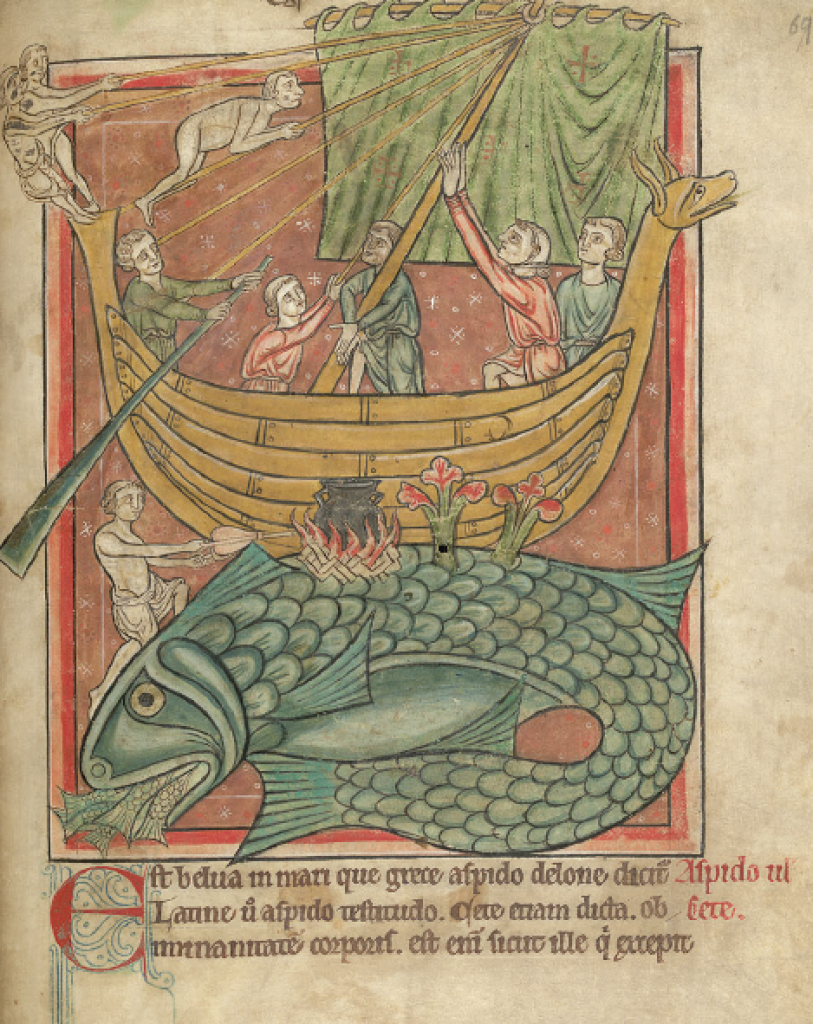
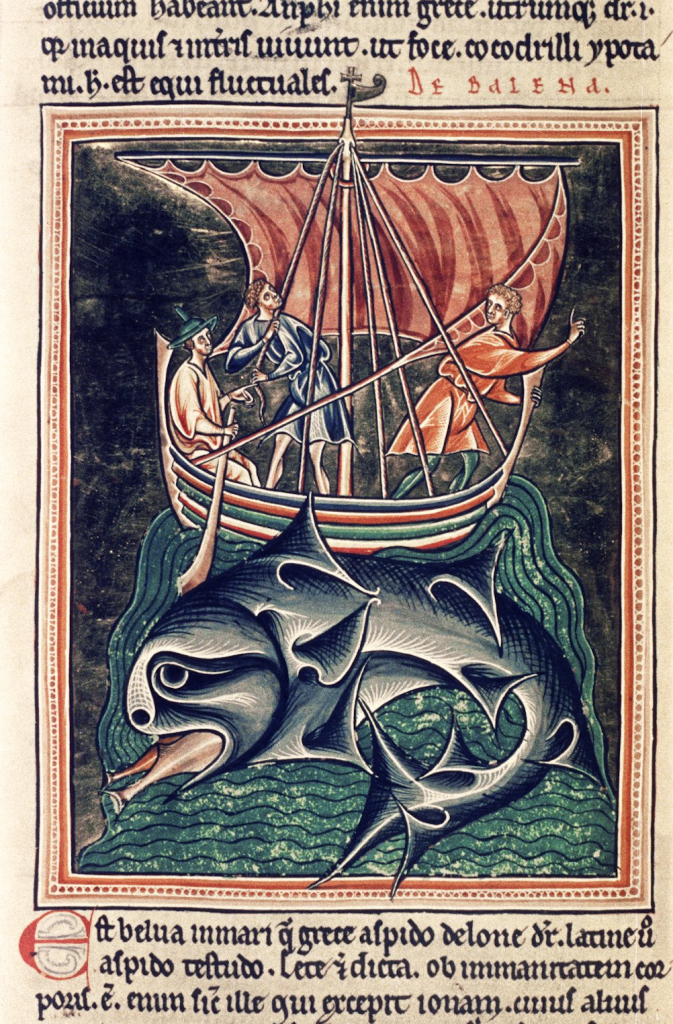
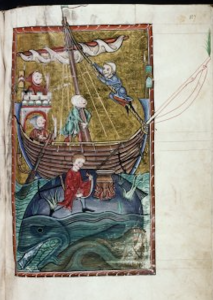
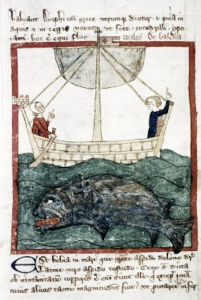
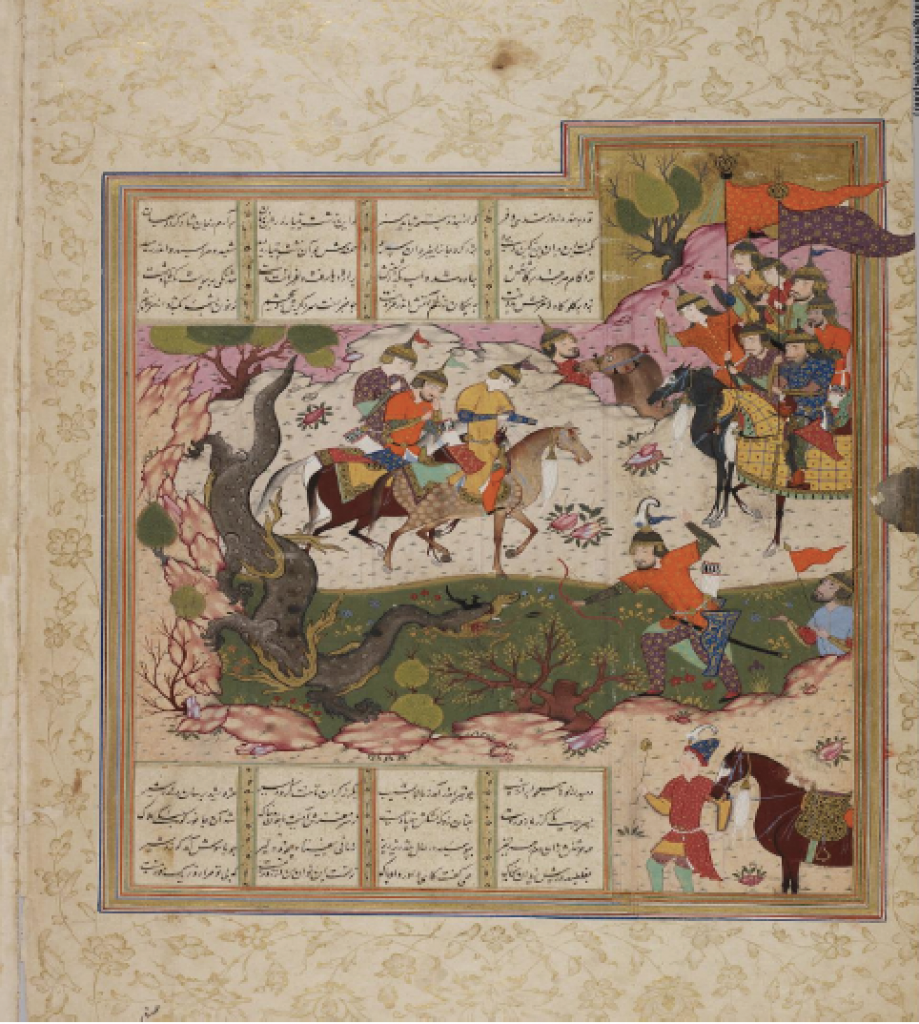
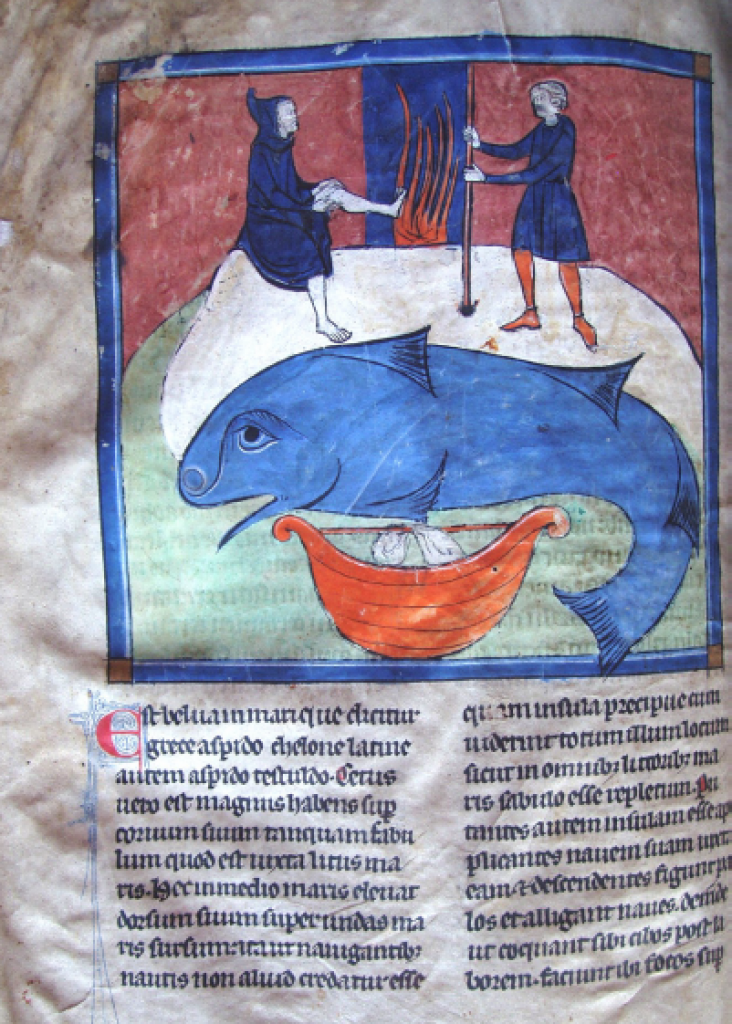
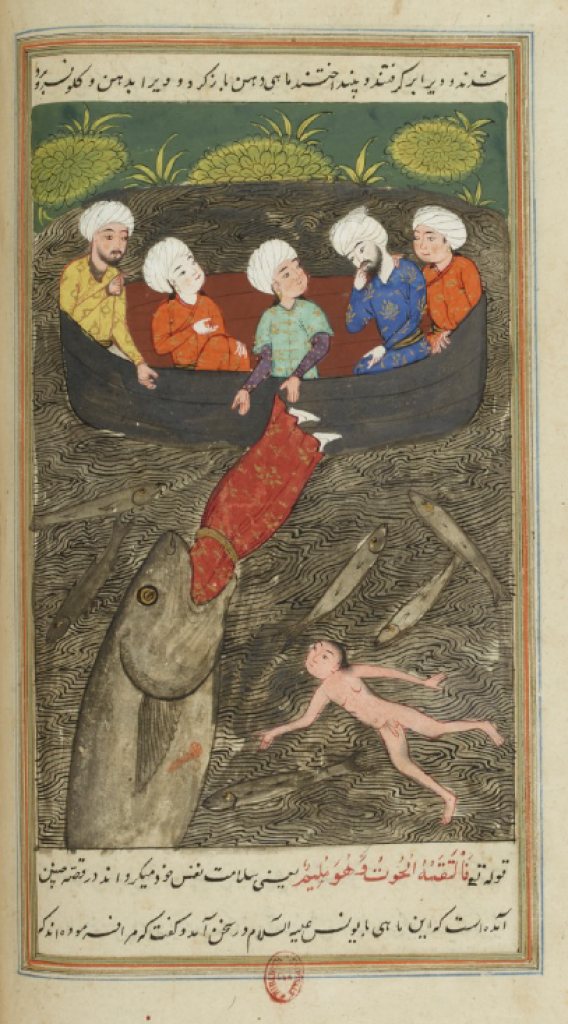
Footnotes
[1] I. Gershevitch, ‘Iranian Literature,’ in Literatures of the East, ed. E.B. Ceadel, London, 1953, p. 63 (quoted from Hinnells p. 46).The early section in this contribution on pre-Islamic Zoroastrian literature and myths is almost entirely based on the writings of my colleague Dr. Mahnaz Moazami which she generously shared with me.
[2] Abu’l-Fażl Beyhaqi, The History of Beyhaqi, tr. C. E. Bosworth and fully revised by Mohsen Ashtiany,Vol. II. Boston and Washington, D.C., 2011, p. 371.
[3] Florence McCulloch, Mediæval Latin and French Bestiaries, Chapel Hill, 1962, pp. 91-92.
For other texts and references to the medieval narrative see: C. C. Coulter, The Great Fish in Ancient and Medieval Story,” Transactions and Proceedings of the American Philological Association, lvii (1926), pp. 32-50. Albert S. Cook (ed.) The Old English Elene, Phoenix, and Physiologus, New Haven, 1919, pp. lxiii-lxxxv. Arnold Clayton Henderson, “Medieval Beasts and Modern Cages: The Making of Meaning in Fables and Bestiaries,” PMLA, xcvii (1982), pp. 40-49. Guy R. Mermier, “The Romanian Bestiary: An English Translation and Commentary on the Ancient ‘Physiologus’ tradition.” Mediterranean Studies XIII (2004), pp. 17-55. W.B.Yapp, “A New Look at English Bestiaries,” Medium Aevum, liv (1985), pp. 1-19. John R. Reinhard, “Florismondo: Ex Damnatissima Amadisi Bibliotheca,” PMLA, 38/3, 1923, pp. 427-70, esp. pp. 448-49 with a wealth of references. Séamus Mac Mathúna, “The Irish Life of Saint Brendan: Textual History, Structure and Date,” in Glyn S. Burgess and Clara Strijbosch, Brendan Legend: Texts and Versions, Boston, 2005, pp. 118-58. Caxton, Mirrour of the World, ed. Oliver H. Prior, ETS extra series no.110, Oxford, 1913, pp. 88-89 (fol.47). Hanneke Wirtjes (ed.) The Middle English Physiologus, EETS, Oxford, 1991.
[4] Jan M. Ziolkowski, Fairy Tales from Before Fairy Tales, The Medieval Latin Past of Wonderful Lies, Ann Arbor, 2009; particularly chapter two: “Between Sacred Legend and Folktale. A Whale of a Story about a Tenth-Century Fisherman”, ref. p. 66. Ziolkowski poses the question of possible origins of the scene: ” What sources of inspiration lay behind the portrayal of this scene in either Collodi or Disney may never be fully known, beyond the obvious fact that children’s stories are widespread in which the motif of “[v]ictims rescued from swallower’s belly” (MI F913) is the crucial turning point.” And goes on to name the most famous of these, the Greek myth of Kronos devouring five of his children as soon as they were born. (pp. 66-67). Interesting coincidence of the mention of both the scorched whale and the more familiar and widely occurring reference to asinine garb and metamorphosis here and in the quoted passage from Beyhaqi.
[5] In general on Kərəsāspa/ Karsāsp see Prods Oktor Skjærvø, “Karsāsp” in EIr. For a meticulously detailed recital of the different and succeeding accounts of Kərəsāspa/ Karsāsp/Garshāsp, pre-Islamic and medieval see H. E. Eduljee, “The Legend of Keresaspa,” Journal of the C. R. Cama Oriental Institute, 50, 1983, pp. 32-86.
[6] Mēnōg ī Xrad 26.52-53.
[7] Dēnkard, 9.15, Madan ed. 794.16; Yasna 34.1-15; in PRDd, chap. 18f, and in Saddar Bundahišn, chap. 20, ed. Dhabhar, 86-92.
[8] Bundahišn, 29.8-9; Anklesaria 254; Dd. 16.6, 35.3; ZVYt. 3.55-61; MX 27.49-53; 62.20-24, and also PRDd. ch. 48.34-5; 50.1.
[9] PRDd chap. 18f.33-34 and Bundahišn, 33.42.
[10] Clément Huart, ed. tr., Le livre de Gershâsp, Paris, 1926; Asadi Ṭusi, Garshāsp-nāme, ed. Ḥabib Yaghmāʾi, second reprint, Tehran, 1354/1975; Asadi Ṭusi, Garshāspnāma, Facsimile edition of the ms. copied in 1066 A.D. (Topkapi Sarayi Müzesi ms. no, H674) ed. Mahmoud Omidsalar and Nader Mottalebi-Kashani, Tehran, 2015. For studies on the fate and fortune of Garshāsp in Persian literature after the rise of Islam see: Ashk Dahlén, “Thematic Features in Iranian National History Writing: The Case of Dāstān-e Goshtāsp (Tale of Goshtāsp)” in Acta Orientalis Upsaliensis. Studia Iranica Upsaliensia 26: (International Shāhnāme Conference), ed. F. Hashabeiky, Uppsala 2014, pp. 13-56. Saghi Gazerani, The Sistani Cycle of Epics and Iran’s National History, Brill, Leiden and Boston, 2016. (Particularly sec.2: pp. 45-69). Dhabiḥ-Allāh Ṣafā, Ḥamāsa-sarāyi dar Irān, Tehran, 1954; pp. 283-89. Marijan Molé, “Garshāsp et les Sagsār,” La Nouvelle Clio, III (1951), pp. 128-38. Marijan Molé, “L’épopée iranienne après Firdōsī, ” La Nouvelle Clio V (1953) p. 377-93. Marjolijn van Zutphen, Farāmarz, the Sistāni History, Leiden and Boston, 2014 (Particularly Sec.3.2: “The Confusing Situation of Garshāsp” pp. 158-61.
[11] A point made by medieval writers themselves, see The Fársnáma of Ibnu’l-Balkhí, ed. G. Le Strange and R. A. Nicholson, London, 1921, pp. 13-14. H.E. Eduljee, p.79; and references in footnote 10 (Gazerani and van Zutphen). For a critical and perceptive review of the traces of the Garshāsp narrative in Persian epic poems see Bahman Sarkārāti, “Bāz-shenāsi baqāyā-ye afsāna-ye Garshāsp dar manẓumehā-ye ḥamāsi-e Irān,” in Nāma-ye Farhangestān, vol.3, no. 10, Summer 1376, pp. 5-38.
[12] C. Edward Sachau, The Chronology of Ancient Nations (tr.& ed. of Biruni’s Al-Āthār al-bāqiya), London 1879; Arabic text, ed. Parviz Azkāei, Tehran, 2001, p. 120.
[13] Beyhaqi, p. 371.
[14] tr. in Edward C. Sachau, Alberuni’s India, (Indian Reprint 1964) Vol. I, p.3. For further references to the ʿiyān/khabar distinction in the context of the texts of the period see Mario Kozah, The Birth of Indology as an Islamic Science: Al-Bīrūnī’s Treatise on Yoga Psychology, Leiden and Brill, 2015, p. 24.
[15] Such as, in Beyhaqi’s case, as in Boccaccio’s De Casibus Vivorum Illustrium and its many imitations, providing succeeding episodes of “Big Men Falling a Long Way,” to quote Christopher Logue (appendix to his unfinished War Music), designed to serve as so many ʿebrat-nāmas to forewarn those in positions of power.
[16] In pre-Islamic texts there is a sub-text to the tale: Some commentaries suggest that the entire episode illustrates the ultimate moral superiority of the priest over the warrior: A priest would have been far more respectful in tending to the fire while Karsāsp had shown the rash impetuosity of a warrior. But in Beyhaqi or in other versions of the story there is no supportive gloss since the narrative has lost its mythic dimension.
[17] For a list of different definitions of myth, intuitive and seemingly more objective and ‘scientific’, see John S. Gentile, “Prologue: Defining Myth: An Introduction to the Special Issue on Storytelling and Myth,” in Storytelling, Self, Society, vol. 7/2, May-Aug. 2011, pp. 85-90; Eric Csapo, Theories of Mythology, Blackwell Oxford, 2005. (Review: Vinciane Pirenne-Delforge, L’Antiquité Classique, Vol. 76, 2007, pp. 404-406.) The difficulties inherent in tailoring a ‘global’ term such as myth to fit particular cultures and literatures appear in the very title and the chapter headings of a recent collection on Arabic literature, and are clearly manifested, if not resolved, in the Introduction by Professor Neuwirth, see Angelika Neuwirth, Birgit Emnaló, Sebastian Günther, Maher Jarrar, eds. Myths, Historical Archetypes and Symbolic Figures in Arabic Literature, Towards a New Hermeneutic Approach (Proceedings of the International Symposium in Beirut, June 25th-June 30th, 1996). Beirut and Stuttgart, 1999.
[18] This does not imply that the citation is unique to Beyhaqi. The same narrative occurs in other medieval texts as a mere marvel, in the genre of fishermen and sailors stories. See for example, Kitāb ‘ajāyib al-Hind ta’lif Buzurk ibn Shahriyār al-Nākhudāh al-Rām Hurmuzi, Livre des merveilles de l’Inde by Bozorg Fils de Chahriyâr de Râmhormoz; Arabic text published based on a manuscript of M. Schefer, & collated with the Constantinople manuscript by P. A. van der Lith, with French translation by L. Marcel Devic, Leiden, 1883-1886, p. 38; tr. into Persian as ʿAjāʾeb-e Hend by Mohammad Malekzādeh, Tehran 1969, p.29. Here, as in some Western versions, the whale is replaced by a gigantic sea turtle.
[19] The authorial invitation to readers to allegorize and adopt a bifocal approach to the text and bear in mind the inner and outer significance (ẓāher&bāṭin) appears in the very beginning of the Shahnameh in the section on its composition (ed. Khaleghi-Motlagh, I, p. 12, ll.113-114). It invites the audience to consider those parts of the narrative which seemingly do not accord with rational ways of thinking as subtle allusions which would also appear plausible once their significance is explained. The Florence manuscript of the Shahnameh goes even further and adds a further eight lines (Khaleghi-Motlagh, I, p. 12. n.3; Facsimile ed. of the Florence Manuscript, Tehran 1990, p. 4) in which the poet (or in all likelihood a later poet-scribe) further shores up his defenses by confessing that he has written to please both the elite and the rabble (ʿām&khāṣ) and that the refined and the sagacious should note that any surviving implausible matter is there in order to please the less perceptive.
[20] This deserves a study to complement Moḥammad Amin Riyāḥi’s Sar Chashmehā-ye Ferdowsi Shenāsi in a more extensively critical and analytical manner. For example one notes ʿAṭṭār’s allegorically didactic section derived from the Bijan and Manijeh story in the Shahnameh enforcing further the mythical and spiritual dichotomy of geographical spaces already present in the Shahnameh with Iran/Turān as opposing lands of religious purity /guile-infested nature respectively (Elāhi-nāmeh, ed. M-R. Shafiʿi-Kadkani, 3rd reprint 2009, p. 183; On symbolic spaces of mythical geography see Yuri M. Lotman, Universe of the Mind, A Semiotic Theory of Culture, tr. Ann Shukman, Bloomington, 1990, p. 171). See also Abbas Amanat and Farzin Vejdani, eds., Iran Facing Others. Identity Boundaries in a Historical Perspective, particularly pt. I: Legacy of Cultural Exclusion and Contested Memory, with contributions by Abbas Amanat, Dick Davis, Sunil Sharma, and Toraj Atabaki, pp. 1-78, New York, 2012. On figurative interpretations by mystics and philosophers see Henry Corbin, En Islam iranien. Aspects spirituels et philosophiques, 4 vols, Paris, 1972; particularly Vol. II: Sohrawardī et les Platoniciens de Perse. Among Shahrokh Meskoub’s several meditative works on the Shahnameh see Sug-e Siyāvash (dar marg o rastākhiz), Tehran 1971.
[21] As in the case of Ārash-e kamāngir discussed at the end of this paper.
[22] Moses Khorenatsʿi, History of the Armenians, tr. & commentary by Robert W. Thomson, Cambridge, Mas., 1978; “From the Fables of the Persians”, p. 126ff.
[23] The diachronic study of mythology provides us with a successive series of retrospective sneers: allegorists mocking uncritical believers in the literal plot of myth and rationalists and those whom one could call post-allegorist interpreters of myth deriding the naive explicatory sentiments of the allegorists.
[24] al-Yaʿqūbī. Ta’rikh, ed. Houtsma, Historiæ 1883, vol. I pp. 178-79. Passage tr. by E. G. Browne in LHP I, pp. 150-51.
[25] As in many other ways, modern interpretations of myth in contemporary Persian literature have been deeply influenced by Romanticism, taken in its broadest sense. The fine and detailed study by Andrew Von Hendy, The Modern Construction of Myth, Bloomington, 2002 contains many observations equally relevant to twentieth century and contemporary Persian critical writings on myth (see also the short but informative review of Von Hendy by Richard P. Martin, MLQ: Modern Language Quarterly, 65/2, 2004, pp. 297-301.)
[26] Shahmardān b. Abi’l-Khayr, Nozhat-nāma-ye ʿAlāʾi, ed. Farhang Jahānpur, Tehran, 1983.
[27] On the many instances of this cutting down to earth tradition in medieval European literature see John Daniel Cooke, “Euhemerism: A Mediæval Interpretation of Classical Paganism,” Speculum vol.2/4, Oct. 1927, pp. 396-410. There are frequent occurrences of euhemeristic glosses in other Persian texts, see for example the already cited Fársnáma of Ibnu’l-Balkhí, ed. G. Le Strange and R. A. Nicholson, London, 1921,p. 29, where the origins of idol worship are explained in terms of the lasting memory of a widespread cholera epidemic in the time of the mythical pre-Islamic Ṭahmurath. The many who had lost their dear ones consoled themselves by making images of them and passed on the tradition to their descendants who began to worship them, regarding them as intercessors with the Almighty, and this, Ibn Balkhi maintains, occurred mostly in India. The same explanation occurs in other texts and is obliquely pertinent to the references to the Quranic asāṭir al-awwalin, a topic discussed briefly later in this paper.
[28] Parallel instances include the many modern works in Persian and Arabic, often written by engineers or medical doctors interpreting and justifying the raison d’être of religious rituals strictly in terms of their inherent benefits to personal hygiene or physical fitness.
[29] As, for example, in the well-known Turk-e Shirazi ghazal where the poet uses one of his favorite interjectory ploys: standing outside the realm of Time and observing the myth of the lovers Yusof and Zuleykha unfold from the outset, from the vantage point of azal.
[30] F. Rosenthal, “Asāṭīr al-Awwalīn” Encyclopædia of Islam, 2nd ed. (The short entry also raises doubts about the etymology of Osṭura (used for myth in Persian and Arabic) from Gk. historia.
On Naḍr b. al-Ḥareth and his claim that his stories of Pre-Islamic Iranian heroes were on a par with the Qur’an see Alfred Guillaume tr., The Life of Muhammad: A Translation of Ibn Isḥāq’s Sīrat Rasūl Allāh, reprint New York, 1997, p. 136.
[31] The opening words of Ibn Muqaffa’ Adab al-kabir is a succinct riposte to criticisms levelled at pre-Islamic culture. His depiction of the Ancients as taller, stronger and blessed with a longer life etc. recalls John of Salisbury’s quotation from Bernard of Chartres “ we are dwarves perched on the shoulders of giants.” Its praise of them for altruistically gathering a vast corpus of knowledge from which their later and less gifted successors could benefit, endows the past with the status of a golden age and looks forward to later views of Zoroaster and Hermes as ancient antediluvian sages. For a recent French translation see Jean Tardy, Annales Islamologiques 27 (1993), pp. 181-223.
[32]Mention of Moses as a prophet: Moscow ed. vol.1. p. 248 line 1641: konun naw shavad dar jahān dāvari cho Musā beyāyad be peighambari. Khaleghi-Motlagh relegates it to his footnotes p. 281
[33] It may be a later interpolation, as at least one scholar has argued, but that is not the issue here.
[34] The contrast with Shahmardān’s portrayal of Rostam is instructive. In the Nozhat-nāma the author focuses on the aspect of the story as “afsāneh” used in the sense of mere fable and designed for light-hearted entertainment: “Now we devote a few chapters on the deeds of Rostam, son of Zāl as a fable (be-tariq-e fesāneh) and there is no harm in that since the name of this work is the book of good cheer (nozhat-nāma) so that will delight the heart and provide another variety of delectation.” p. 319; And on the same page he uses “qeṣṣe” which can denote ‘story’ whether true or not. Note also that: his popular story telling account contrasts sharply with Ferdowsi’s. It is a series of disparate scenes culled from a shared master narrative with little care for consistency (Bahrām-e Gur pops up on the scene far earlier than expected).
[35] For references to both early and modern literature on Ārash, see the entry in EIr.online: http://www.iranicaonline.org/articles/aras-avestan-erexsa Parallels with Vishnu and Philoctetes have also been drawn in some research papers.
[36] On the identification of Āraš with the bowman on the reverse of Arsacid coins see V. G. Lukonin, in the Cambridge History of Iran III, Cambridge, 1983, p. 686.
